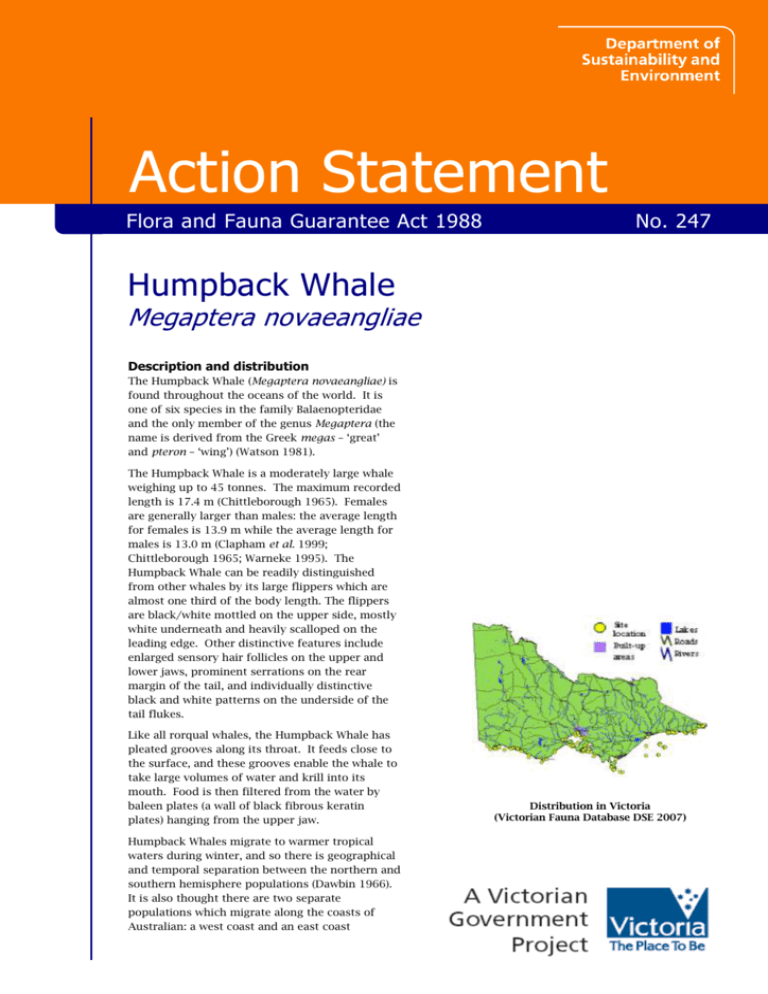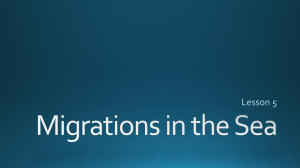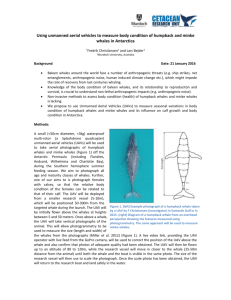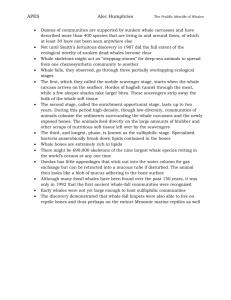Humpback Whale (Megaptera novaeangliae) accessible
advertisement

Action Statement Flora and Fauna Guarantee Act 1988 No. 247 Humpback Whale Megaptera novaeangliae Description and distribution The Humpback Whale (Megaptera novaeangliae) is found throughout the oceans of the world. It is one of six species in the family Balaenopteridae and the only member of the genus Megaptera (the name is derived from the Greek megas – ‘great’ and pteron – ‘wing’) (Watson 1981). The Humpback Whale is a moderately large whale weighing up to 45 tonnes. The maximum recorded length is 17.4 m (Chittleborough 1965). Females are generally larger than males: the average length for females is 13.9 m while the average length for males is 13.0 m (Clapham et al. 1999; Chittleborough 1965; Warneke 1995). The Humpback Whale can be readily distinguished from other whales by its large flippers which are almost one third of the body length. The flippers are black/white mottled on the upper side, mostly white underneath and heavily scalloped on the leading edge. Other distinctive features include enlarged sensory hair follicles on the upper and lower jaws, prominent serrations on the rear margin of the tail, and individually distinctive black and white patterns on the underside of the tail flukes. Like all rorqual whales, the Humpback Whale has pleated grooves along its throat. It feeds close to the surface, and these grooves enable the whale to take large volumes of water and krill into its mouth. Food is then filtered from the water by baleen plates (a wall of black fibrous keratin plates) hanging from the upper jaw. Distribution in Victoria (Victorian Fauna Database DSE 2007) Humpback Whales migrate to warmer tropical waters during winter, and so there is geographical and temporal separation between the northern and southern hemisphere populations (Dawbin 1966). It is also thought there are two separate populations which migrate along the coasts of Australian: a west coast and an east coast 1 population. Humpback Whales passing through Victorian waters are generally considered to be from the east coast population, and may be seen during either the northward migration (May – August) or the southern migration (September – November). Habitat Humpback Whales in the southern hemisphere generally migrate north in winter (May - August) to breed and calve in sub-tropical waters (latitudes 15 - 20 S). Whales migrating up the east coast may travel as far north as southern Queensland. They then migrate south to Antarctic waters (latitudes 55 – 60 S) in September to November where they remain over summer to feed, mainly on krill (DEH 2005a). In temperate and tropical waters, Humpback Whales are often seen in coastal or shelf waters (Dawbin 1966; Clapham & Mead 1999). Key calving and breeding areas off eastern Australia include the coastal waters of the southern NSW coast, Coffs Harbour, Cape Byron, Hervey Bay, North Stradbroke Island and Whitsunday Islands (Bannister et al. 1996). On their southern migration to feeding grounds, cow-calf pairs are generally found close to shore and use sheltered bays to rest (DEH 2005). Known resting areas include Hervey Bay, the Whitsunday Islands in Queensland and Twofold Bay and Cape Byron in New South Wales (DEH 2005a). Some Humpback Whales do not migrate each year, instead remaining in tropical or Antarctic waters (Bannister et al. 1996; Thiele et al. 2001). Whales that remain in Antarctic waters are probably females, as there are more males than females on the migration route (Brown et al. 1995) and historical catch data describes equal numbers of both sexes in Antarctic waters (DEH 2005). Life history and ecology Humpback Whales have a life expectancy of approximately 50 years. The mating and calving season is June – October, and females generally calve every two to three years following a gestation of 11 - 11.5 months. Calves are 4 - 4.6 m long and weigh approximately two tonnes at birth. They are weaned at approximately 11 months of age when they are 8 - 10 m in length (Chittleborough 1965; Bannister et al. 1996; Clapham et al.1999). Calves are known to be attacked by sharks and killer whales (Bannister 1989; DEH 2005). Both sexes reach puberty at approximately four to five years of age (Chittleborough 1965; Bannister 1989), but may not reach physical maturity until 12 - 15 years old (Chittleborough 1965; Bannister et al. 1996). Humpback Whales are principally solitary animals, although they travel in mother and calf pairs and in small groups during migration. While these small groups are segregated into age, sex and reproductive class, they do not appear to consist of related animals, apart from mother and calves (Valsecchi et al. 2002). Humpback Whales are slow swimmers reaching maximum speeds of 14 km/h (Forestell et al. 2001). During migration, however, they generally swim between < 1 km/hr and 6 km/h. Like other whales, Humpback Whales communicate by producing low frequency sounds (20 Hz – 10 kHz). These sounds are used for normal communication or may be associated with breeding: males have been recorded ‘singing’ while at, or while migrating to or from, breeding grounds (Cato 1991; Cato et al. 2001). Songs are continually evolving, may change progressively over seasons, and can be used to distinguish between populations (Cato 1991; DEH 2005). Conservation status Internationally, the Humpback Whale (Megaptera novaeangliae) is listed as vulnerable by the International Union for the Conservation of Nature (IUCN). It is also protected under a variety of international agreements. In Australia, it has been listed as vulnerable under the Commonwealth Environment Protection and Biodiversity Conservation Act 1999 (EPBC Act). The EPBC Act provides protection for all cetaceans in all Commonwealth waters. The Humpback Whale is also protected under legislation in the waters of all states and territories of Australia. In Victoria, the Humpback Whale is protected under the Wildlife Act 1975 and was listed as threatened under the Flora and Fauna Guarantee Act 1988 (FFG Act) in 1995. It is considered vulnerable in Victoria according to the Department of Sustainability and Environment’s Advisory List of Threatened Vertebrate Fauna in Victoria – 2007 (DSE 2007). Decline and threats Humpback Whale stocks in the southern hemisphere have been subject to commercial whaling since the mid-1800s. Predictable migratory patterns and proximity to coastal habitat meant Humpback Whales were easily exploited from shore-based stations. Commencement of pelagic fishing in Antarctic waters in 1912 significantly expanded harvest potential. More than 200 000 individuals were taken in the twentieth century, including thousands of illegal catches taken up to 1973, well after the 1963 International Whaling Commission (IWC) moratorium on the taking Humpback Whales (Findlay 2001; Patterson 2001). In 1986, the IWC agreed to an international ban on all commercial whaling, and the Humpback Whale has since shown signs of recovery. The east coast Australian population has been recovering at a rate of approximately 11 % per year from 1978 to 1999 2 (Paterson et al. 2001; DEH 2005a). However, the 1999 estimate of a population of 3100 – 4000 individuals is still well below pre-whaling numbers (estimated at 27 000 individuals) (DEH 2005a). The possibility of Humpback Whales being subject to some type of whaling in the future still persists. Japan’s proposal to permit the taking of 50 Humpback Whales as part of its research program was not supported at the 2005 IWC meeting. The Intergovernmenal Panel on Climate Change has concluded that human activity is contributing to global warming (IPCC, 2007). While the exact outcomes of global warming are not known, Southern Ocean ecosystems are predicted to experience reductions in productivity and sea ice, unpredictable weather events caused by increasing ocean water temperatures, changes in ocean currents and rises in sea levels (DEH 2005a). The potential impacts of these events on Humpback Whales are: Loss of suitable habitat for Humpback Whale migration, feeding, resting and calving site selection. Changes to prey species productivity, distribution and availability. Victoria. Given the rate of recovery of Humpback Whale populations, the impact of these entanglements is likely to be on individuals rather than the population. There are currently no shark safety nets in Victorian waters or aquaculture operations that could cause entanglements. However fishing gear and marine debris pose a threat in Victorian waters. Human-related underwater noise – includes noise as a result of boating, shipping, sonar signals, blasting and seismic surveys that use air gun pulses. While the specific impacts of these noise signals are unknown, they may affect communication between individuals or the ability of individuals to navigate. The impacts of underwater noise are influenced by the characteristics of the sound signal, including distance from the source, duration of the sound and sound frequency. Disturbance as a result of noise may be sufficient to deter individuals from significant locations such as feeding areas or migratory routes. The need to minimise disruption to whale behaviour during seismic testing is recognised in the Australian Guidelines on the application of the Environment Protection and Biodiversity Conservation Act 1999 (EPBC Act) to interactions between offshore seismic operations and larger cetaceans. Boating and shipping occur throughout Victoria, and seismic surveys are undertaken in Bass Strait and the Otway Basin (an area covering hundreds of square kilometres). Disruption as a result of tourism – includes recreational and commercial whale watching activities. The threat posed by disruption is recognised at a national level. The Australian National Guidelines for Whale and Dolphin Watching (2005) have been developed as a guide for these activities to minimise disruption of whale behaviour. Victorian legislation also prescribes minimum approach distances for whale watching in Victorian waters. Ship strikes, oil spills & marine debris – includes collision with vessels, ingestion or smothering by oil, and ingestion of marine debris (particularly plastics). There are regular incidences of vessels colliding with Humpback Whales in Australian waters, and there is potential for this to increase as populations recover and more individuals traverse shipping channels. Humpback Whales, however, may also be vulnerable to the cumulative effects of less significant threats. This is a particular issue as the long lifespan and slow rate of maturity of Humpback Whales means that population recovery to pre-whaling levels is likely to be slow. While Humpback Whales are exposed to international threats, including those outlined above, this Action Statement only focuses on those threats relevant to Victorian waters. These include: Entanglement – may occur as a result of marine debris, fishing gear, aquaculture equipment or shark safety nets. The Humpback Whale’s long flippers are likely to make it more vulnerable to entanglements. This threat is recognised in the Humpback Whale Recovery Plan 2005-2010 (DEH 2005a) and the Action Plan for Australian Cetaceans (Bannister et al. 1996). There have been 60 records of entanglements involving Humpback Whales since 1990. Over half of these entanglements were from Western Australian waters, where incidents have increased exponentially in recent years (D Coughran pers. comm.). The west coast population is estimated to be two to three times the size of the east coast population; both populations are increasing at a similar rate (DEH 2005a). As Humpback Whale populations continue to increase, the likelihood of further entanglements will also increase, including in Victorian waters. At present, only a few entanglements have been recorded in As Humpback Whales are dependent on in-shore areas at particular times of the year, individual animals may be subject to the impacts of any or all of these activities. 3 Existing conservation measures International arrangements International Whaling Commission (IWC) was established in 1946 to provide for the proper conservation of whale stocks and enable the orderly development of the whaling industry. Key measures implemented by the IWC include Whale Sanctuaries in the Indian Ocean (1979) and Southern Ocean (1994; reviewed in 2004), and moratoriums banning the taking of Humpback Whales (1963) and all commercial whaling (1986). Action Plan for Australian Cetaceans (Bannister et al. 1996) covers 43 species of cetaceans in Australian waters, including Humpback Whales. It reviews threats and conservation statuses, and recommends priority actions for research and management. Australian National Guidelines for Whale and Dolphin Watching promotes minimum standards to apply in state, territory or Commonwealth waters for the management of whale watching. EPBC Act Policy Statement 2.1 – interaction between offshore seismic exploration and whales (DEWHA 2008) provides practical standards and a framework for seismic survey operations to minimise the risk of acoustic injury to whales, and minimise disturbance to whales in biologically important habitat areas or during critical behaviours. This policy applies in Commonwealth waters and also provides the minimum standards that would apply in state waters. Australian Whale Sanctuary, which was declared under the EPBC Act, protects whales within Australia’s Exclusive Economic Zone (three nautical miles to 200 nautical miles offshore), including Antarctic waters around Macquarie Island Park, and Heard and McDonald Islands Marine Reserve. Marine protected areas: Great Barrier Reef National Park, Ningaloo Marine Park, Marmion Marine Park, Hervey Bay Marine Park and Morton Bay where special restrictions may apply to protect Humpback Whales from disturbance while utilising these areas. Convention for the Conservation of Antarctic Marine Living Resources (CCAMLR) was established in 1982 as part of the Antarctic Treaty System. Its aim is to conserve marine life in the Southern Ocean and promote the sustainable management of resources. Whales, which are the subject of another convention (IWC), are excluded from this convention. However, the management of other marine life (including krill, which is fundamental to Humpback Whale survival) is considered under this convention. Convention for the Conservation of Migratory Species of Wild Animals (CMS) was established in 1979 under the United Nations Environment Program to conserve terrestrial, marine and avian species throughout their ranges by providing a framework convention for management actions. The Humpback Whale is listed in Appendix I –endangered migratory species. Convention on International Trade of Endangered Species (CITES) was established in 1975. Its aim is to ensure that international trade in wild animals and plants does not threaten their survival. The Humpback Whale is listed in Appendix I – Species threatened with extinction, and trade would only be permitted in exceptional circumstances. Convention on Biological Diversity was established in 1992 under the United Nations Environment Program at the Rio Earth Summit. It aims to conserve biological diversity, ensure sustainable use of its components and have fair and equitable sharing of benefits from commercial and other utilisation. National measures Humpback Whale Recovery Plan 2005-2010 has been released by the Commonwealth Department of the Environment, Water, Heritage and the Arts. The plan outlines measures necessary for the recovery of Humpback Whales that utilise Australian waters so that the species can be considered secure in the wild in accordance with Part 13, Division 5 of the EPBC Act. State measures Victorian Wildlife Act 1975 provides protection for Humpback Whales in Victorian waters. Victorian Wildlife (Whales) Regulations 1998 prescribes minimum approach distances for persons in the vicinity of whales, including for whale watching in Victorian waters. These regulations are currently (2009) being updated. Victorian Cetacean Contingency Plan is maintained by DSE and provides for management of strandings and entanglements. This is currently being reviewed (2009). Victorian Rock Lobster Fishery Code of Practice for Reducing Whale Entanglements was developed in 2004 between DSE and the Victorian fishing industry to reduce the probability of entanglements in ropes associated with lobster pots. All whale-related incidents in Victorian rock lobster fisheries must be logged and reported to the relevant authorities. 4 Conservation Objectives Long term objective To ensure that the Humpback Whale can survive, flourish and retain its potential for evolutionary development in the wild. Objectives of this Action Statement 1. Minimise human impacts on Humpback Whales. 2. Improve understanding of the distribution, abundance and migration patterns of Humpback Whales in Victorian waters. Intended management actions Many of the human activities that threaten Humpback Whales, such as killing, injuring and disturbing individuals, are banned in Victorian waters or are already subject to controls. The actions outlined below therefore aim to maintain these arrangements to protect the species in Victoria. In recognition of the fact that threats to Humpback Whales still occur outside Victoria, this Action Statement also aims to support international and national arrangements to manage threats. The intended management actions listed below are further elaborated in DSE’s Actions for Biodiversity Conservation (ABC) system. Detailed information about the actions and locations, including priorities, is held in this system and will be provided annually to land managers and other authorities. Objective I To minimise human impacts on Humpback Whales. Action Targets 1. Support the implementation of the Victorian Rock Lobster Fishery Code of Practice for Reducing Whale Entanglements. Annual reporting on actions undertaken to raise and maintain awareness of the code of practice within the rock lobster fishing industry. Seafood Industry of Victoria, Department of Primary Industries (DPI) 2. Establish a mechanism for commercial fishers to report interactions with Humpback Whales in Victorian territorial waters. Reporting mechanism established to allow commercial fishers to report interactions with protected wildlife, including Humpback Whales. DPI, DSE Reports evaluated annually and recommendations arising submitted to responsible authorities for consideration. Annual training exercises undertaken to maintain currency of skills for disentangling whales. Closer liaison established between government and the Marine Stranding Network. Reporting mechanism established to provide for reporting and review of deaths of whales, including Humpback Whales, in Victorian waters. Continue to implement existing measures such as the management of whale watching regulations in Victorian waters. Replace the Victorian Wildlife (Whales) Regulations 1998 with the Victorian Wildlife (Marine Mammals) Regulations 2009 to implement the Australian National Guidelines for Whale and Dolphin Watching in Victoria. DSE 5. Develop guidelines for seismic activity Victorian guidelines for seismic activity developed and implemented, based on DSE 3. 4. Maintain preparedness to respond to entangled and stranded whales in Victorian waters. Responsible DSE, DPI, Parks Victoria 5 in Victorian waters. the EPBC Act Policy Statement 2.1 – interaction between offshore seismic exploration and whales. 6. Support action in international forums for the protection of Humpback Whales. Annual communication and liaison with the Australian Department of the Environment, Water, Heritage and the Arts, and other states and territories regarding whale protection matters. DSE 7. Assess and manage disturbances from oil and gas exploration and development, shipping, and recreational boating. Appropriate planning processes, industry guidelines and state/Commonwealth government regulations to reduce disturbances developed and applied. DSE 8. Reduce the likelihood of whales being entangled in marine debris and marine industry equipment. Appropriate guidelines/codes of practice for industry developed to reduce the likelihood of whale entanglement. DSE Objective II To improve understanding of the distribution, abundance and migration patterns of Humpback Whales in Victorian waters. Action Targets Responsible 9. Surveys completed as required to update the national database. DSE Support and input into population research provided. DSE Contribute to national monitoring programs where appropriate to Victoria. 10. Support and provide input into research on Humpback Whale population structures and limits. Objective III To increase community awareness and support. 11. Develop and implement education programs to inform marine users of best practice behaviours when interacting with whales. Education programs about best practice behaviours developed and implemented DSE 6 References Bannister, J.L. (1989) 52. Balaenopteridae in Walton, D. W. & Richardson, B. J. (eds) Fauna of Australia. Mammalia. Canberra: Australian Government publishing Service Vol. 1B. Thiele, D., Hofmann, E., Friedlander, A., Moore, S., McDonald, M. (2001), Preliminary report on IWC-SO GLOBEC collaborative research in the western Antarctic peninsula study area March-June 2001, report SC/53/E8, www.ccpo.odu.edu/Research/globec_menu.html Bannister, J.L., Kemper, C.M. & Warneke R.M. (1996) The Action Plan for Australian Cetaceans. Biodiversity Group, Environment Australia. Valsecchi, E., Hale, P., Corkeron, P., Amoss, W., (2002), Social structure in migrating humpback whales (Megaptera novaeangliae), Molecular Ecology 11: 507-518, Blackwell Science Ltd. Brown, M., Corkeron, P.J., Hale, P.T., Schultz, K.W. Bryden, M.M. (1995) Evidence for a sex-segregated migration in the Humpback Whale (Megaptera novaeangliae), Proceedings of the Royal Society of London B 259:229-234. Warneke, R.M. (1995) Humpback Whale, Megaptera novaeangliae, In Mammals of Victoria: distribution, ecology and conservation, Ed. Menkhorst, P.W., published by Oxford University Press. Cato, D.H. (1991) Songs of humpback whales: the Australian perspective, Memoirs of the Queensland Museum 30(2): 277-290. Watson, L. (1981) Sea Guide to Whales of the World, published by Hutchinson Group Australia Pty Ltd. Cato, D.H., Paterson, R.A., Paterson, P. (2001) Vocalisation rates of migrating humpback whales over 14 years, Memoirs of the Queensland Museum 47(2): 481-489. Chittleborough, R.G. (1965) Dynamics of two populations of the Humpback Whale Megaptera novaeangliae (Borowski), Aust. J. Mar. Freshw. Res., 1965,16, 33-128. Clapham, P.J., Mead, J.G. (1999) Megaptera novaeangliae, Mammalian Species No. 604, pp 1-9, published 5 May 1999 by the American Society of Mammalogists. Clapham, P.J., Wetmore, S.E., Smith, T.D., Mead, J.G., (1999) Length at birth and at independence in humpback whales, J. Cetacean Res. Manag., Vol. 1 No.2 pp141-146, 1999. Coughran D., Western Australian Department of Conservation and Land Management, pers. comm. Dawbin, W.H., (1966) The Seasonal Migratory Cycle of Humpback Whales, In Whales, Dolphins and Porpoises, Ed. Norris, K., University of California Press, Berkeley and Los Angeles 1966. DEH (2005). Megaptera novaeangliae In Species Profile and Threats Database, Department of Environment and Heritage, Canberra. Available from: http//www.deh.gov.au/sprat. Accessed 3/8/2005. DEH (2005a). Humpback Whale Recovery Plan 2005 - 2010. Published by Commonwealth of Australia, June 2005. DEWHA (2008) EPBC Act Policy Statement 2.1 – interaction between offshore seismic exploration and whales. Department of the Environment, Water, Heritage and the Arts. Canberra. Australia. Available online: www.environment.gov.au DSE (2007) Advisory List of Threatened Vertebrate Fauna in Victoria – 2007. Department of Sustainability and Environment. East Melbourne, Australia. This Action Statement has been prepared under section 19 of the Flora and Fauna Guarantee Act 1988 under delegation from Mr Peter Harris, Secretary, Department of Sustainability and Environment, July 2009. Published by the Victorian Government Department of Sustainability and Environment Melbourne, July 2009 © The State of Victoria Department of Sustainability and Environment 2009 This publication is copyright. No part may be reproduced by any process except in accordance with the provisions of the Copyright Act 1968. Findlay, K.P. (2001) A review of humpback whale catches by modern whaling operations in the Southern Hemisphere, Memoirs of the Queensland Museum 47(2): 411-420. Authorised by the Victorian Government, 8 Nicholson Street, East Melbourne. Forestell, P.H., Paton, D.A., Hodda, P., Kaufman, G.D., (2001), Observations of a hypo-pigmented humpback whale (Megaptera novaeangliae), off east coast Australia: 19912000; Memoirs of the Queensland Museum 47 (2): 437450, Brisbane. ISSN 1448-9902 IPCC (2007) Fourth Assessment Report: Climate Change 2007. United Nations Intergovernmental Panel on Climate Change. www.ipcc/ch Paterson, R.A. (2001) Exploitation of humpback whales, Megaptera novaeangliae, in the South West Pacific and adjacent Antarctic waters during the 19th and 20th Centuries, Memoirs of the Queensland Museum 47(2): 421429. Brisbane. Paterson, R., Paterson, P., Cato, D. (2001), Status of humpback whales, Megaptera novaeangliae, in east Australia at the end of the 20th Century, Memoirs of the Queensland Museum 47(2): 579-586. Brisbane. SAC (2000) Final Recommendation on a nomination for listing: Humpback Whale Megaptera novaeangliae (Nomination No. 482). Scientific Advisory Committee, Flora and Fauna Guarantee. Department of Natural Resources and Environment: Melbourne For more information contact the DSE Customer Service Centre 136 186 Disclaimer This publication may be of assistance to you but the State of Victoria and its employees do not guarantee that the publication is without flaw of any kind or is wholly appropriate for your particular purposes and therefore disclaims all liability for any error, loss or other consequence which may arise from you relying on any information in this publication. Accessibility If you would like to receive this publication in an accessible format, such as large print or audio, please telephone 136 186, 1800 122 969 (TTY), or email customer.service@dse.vic.gov.au This document is also available in PDF format on the Internet at www.dse.vic.gov.au 7






